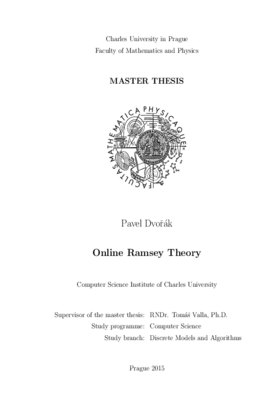Online Ramsey Theory
Online Ramseyova teorie
diplomová práce (OBHÁJENO)

Zobrazit/
Trvalý odkaz
http://hdl.handle.net/20.500.11956/66101Identifikátory
SIS: 159271
Kolekce
- Kvalifikační práce [10932]
Autor
Vedoucí práce
Oponent práce
Koucký, Michal
Fakulta / součást
Matematicko-fyzikální fakulta
Obor
Diskrétní modely a algoritmy
Katedra / ústav / klinika
Informatický ústav Univerzity Karlovy
Datum obhajoby
3. 6. 2015
Nakladatel
Univerzita Karlova, Matematicko-fyzikální fakultaJazyk
Angličtina
Známka
Výborně
Klíčová slova (česky)
online Ramseyho hra složitost strategieKlíčová slova (anglicky)
online Ramsey game complexity strategyOnline Ramseyho hra je hra dvou hráčů, označovanými jako Builder a Painter. V každém kole Builder postaví hranu grafu a Painter ji nabarví červeně nebo modře. Builder vyhraje, pokud se po nějakém kole objeví v nabarveném grafu jednobarevná kopie daného grafu H, jinak vyhraje Painter. V této práci zkoumáme výpočetní složitost odvozeného rozhodovacího problém a ukážeme, že je PSPACE-úplný. Navíc se zabýváme verzí hry, kdy Builder může stavět jen rovinné grafy, a zobecněním hry pro hypergrafy. Nalezli jsme novou třídu grafů nevyhnutelných na rovinných grafech. Ukázali jsme, že Builder vyhraje online Ramseyho hru na 3-uniformních hyperlesech, pokud je cílový graf H je 1-degenerovaný. 1
An online Ramsey game is a game between Builder and Painter, alternating in turns. In each round Builder draws an edge and Painter colors it either red or blue. Builder wins if after some round there is a monochromatic copy of the fixed graph H, otherwise Painter is the winner. In this thesis we investigate the computational complexity of the related decision problem and we show that it is PSPACE-complete. Moreover, we study a version of the game when Builder can draw only planar graphs and a generalization of the game for hypergraphs. We found a new class of graphs unavoidable on planar graphs. We provide a result showing that Builder wins the online Ramsey game on 3-uniform hyperforests when the goal graph H is 1-degenerate. 1
